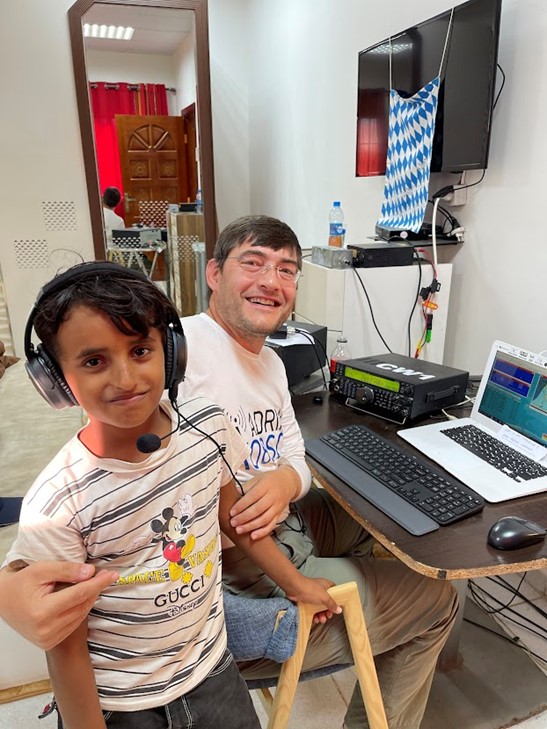As I write these lines (November 6, 2022), the 2022 Mediterraneo DX Club DXpedition to Djibouti with the callsign J28MD is coming to an end. The team effort and the good propagation produced a good number of QSOs (over 90k). Everyone on the team is in good spirits and preparing for the long way home.
Djibouti
Djibouti is a country about the size of New Jersey and has a predominantly Muslim population. Formerly known as French Somaliland, the country took its name as Djibouti when it gained independence from France in 1977. The country is located in the Horn of Africa and is bordered by Somalia, Ethiopia, Eritrea, and the Red Sea. The Port of Djibouti is a maritime port strategically positioned near the world’s busiest shipping lanes.
Our Location
The team leaders found an excellent operating location about a one-hour drive from Djibouti’s capital in Arta province. The site is located on the top of a hill, 700m (2,000 feet) above sea level. The location is a hotel which also serves as a training center for young people learning the skills for working in the hospitality industry.
Radio Equipment
The radio equipment consisted of five Kenwood TS-590 radios (a small, light, performance radio with an RX input) and four ACOM 1011 light, portable, 600W amplifiers. These were used for the following four operating positions:
- CW only
- DIGITAL: RTTY and FT8
- MIX: CW and SSB
- SSB only
For EME operation a Yaesu FT-857 radio was used with a 1KW amplifier (PHOENIX 1000 50/70 /144 MHz). There was also a sixth TS-590 radio dedicated to the 6M FT8 operation position. All QSO logging laptops run Windows 10 with the WinTest logging software.
One interesting aspect is the fact that our DXpedition provided almost real-time logging online via the Internet, using HRDlog, allowing hams to see their QSOs posted a few minutes after working our DXpedition.
The Team
The J28MD team is made up of 15 international ham operators from Italy, France, Germany, Romania, and the U.S. The team members met at the start of the DXpedition on October 27, 2022, at the Busto Arsizio Radio Club. The Italian hosts at the radio club outside Milan did an incredible job of making all of us feel welcome. Italian pasta prepared at the club and wine were of course the staples of the served lunch. The clubhouse was the stage for gathering all the equipment and team members before the journey to Djibouti. This has been a tradition for Mediterraneo DX Club DXpeditions.
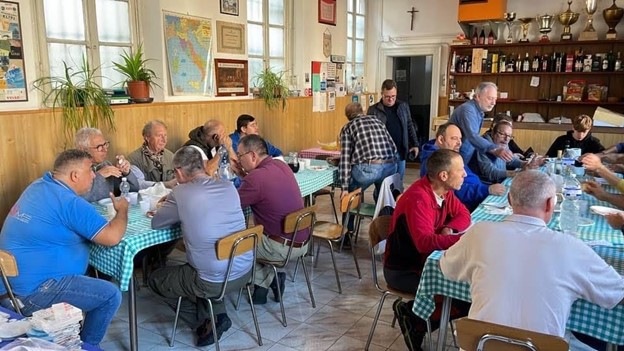
J28MD team meeting in Milan at the Busto Arsizio Radio Club
Each DXpedition member brings to the team skills that enhance the overall success of the DXpeditions. These are technical skills acquired from participating in previous DXpeditions or as part of their daily-life jobs: antenna designers, IT consultants, engineers, etc.
On Saturday evening, other skills were revealed when Martino, IU8LMC, exercised his culinary skills in the hotel’s kitchen to prepare an excellent Italian dinner for the team with pasta, gnocchi, and pizza.
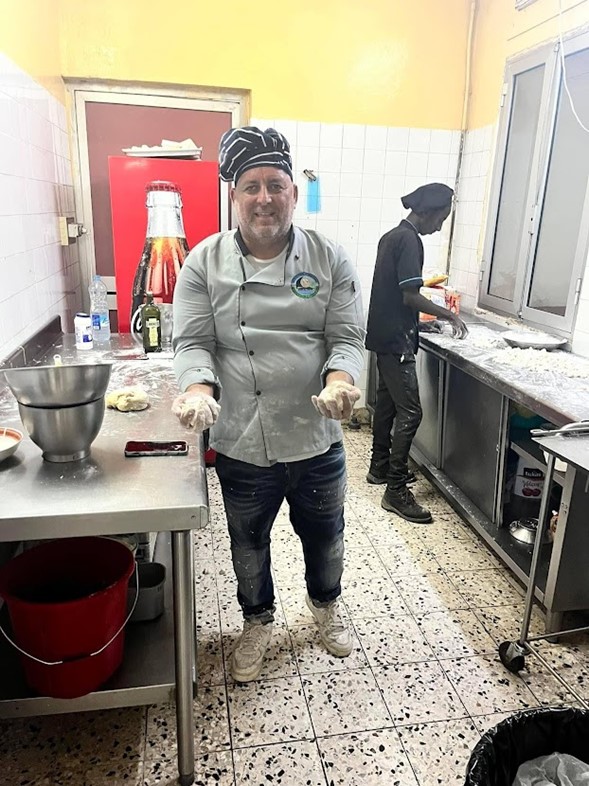
Martino, IU8LMC exercising his culinary skills
The J28MD team members are:
- IZ8CCW, Antonio, team leader
- IZ4UEZ, Dario, organizational support and low bands
- IZ2GNQ, Marco, technical manager
- IZ3GNG, Marco
- YO8WW, Gabi
- DL8JJ, Emil
- DL6LZM, Peter
- IK4QJF, Fabio
- NG7M, Max
- KO8SCA, Adrian
- DJ5IW, Gerhard
- DL8OBF, Uwe
- IU8LMC, Martino
- AG4W, Steve
- F6IRA, Gilles
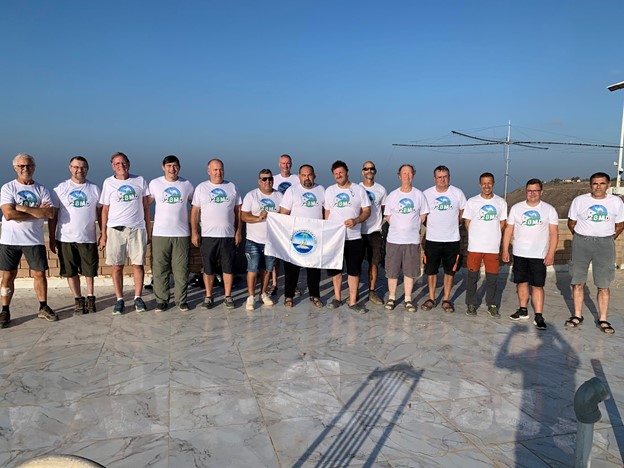
Antennas
The main ingredients of any DXpedition are the antennas. J28MD had a wide array of antennas raised in the air or laid on the ground to allow multiple modes of operation simultaneously in the same band (in-band operation).
- Four Spiderbeam wire beams for 10/15/20/40m, as well as the WARC bands, which generated the bulk of the QSOs and took advantage of the incredible openings that we witnessed on the 12m and 10m bands
- 80m vertical with 16 ground radials built on a fiberglass Spiderpole
- 160m Spiderbeam wire vertical on an 18m fiberglass pole with a capacitive hat
- BOG (Beverage On the Ground) RX antennas for NA/EU/AS that were shared by multiple stations and used for 160/80/40m operating
- 40m and 60m verticals
- 80m dipole raised between three street light poles
- 6m Hexbeam
- 2m beam with 16 elements, designed by I0JXX
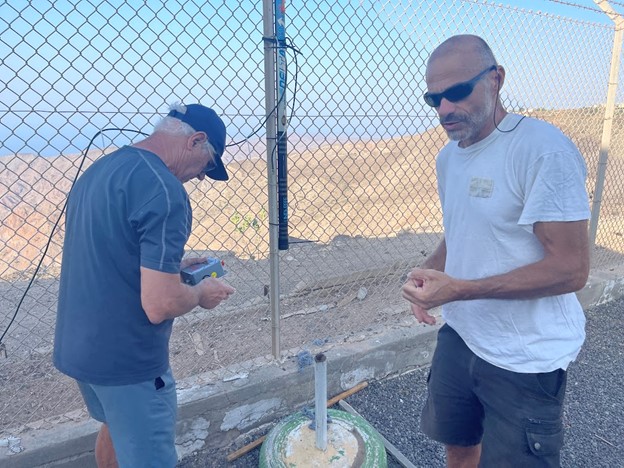
Gilles, F6IRA, and Dario, IZ4UEZ, adjusting one of the vertical antennas
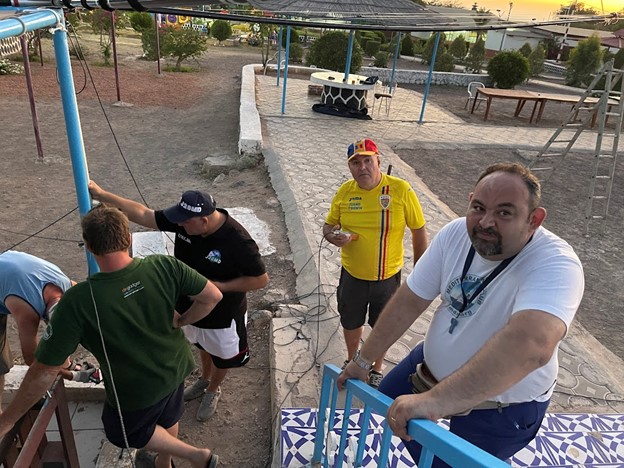
Team members IZ3GNG, IZ2GNQ, IU8LMC, YO8WW, and the team leader IZ8CCW raising a wire beam antenna
Although the hotel is fenced in, some wildlife would always find its way in. The large monkeys (sacred baboons) seem to particularly enjoy chewing the 160m antenna radial wires. There were also some camels on the premises that the staff attempted to ride, and sometimes we had to make minor antenna repairs as a result.
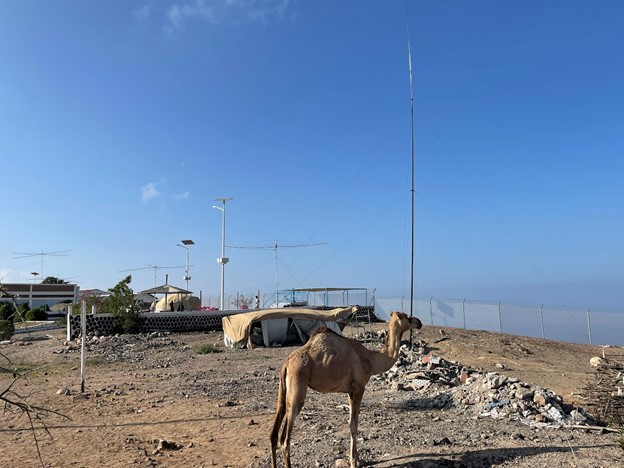
A camel walking by our Spiderbeam wire beam antennas and the 80m vertical
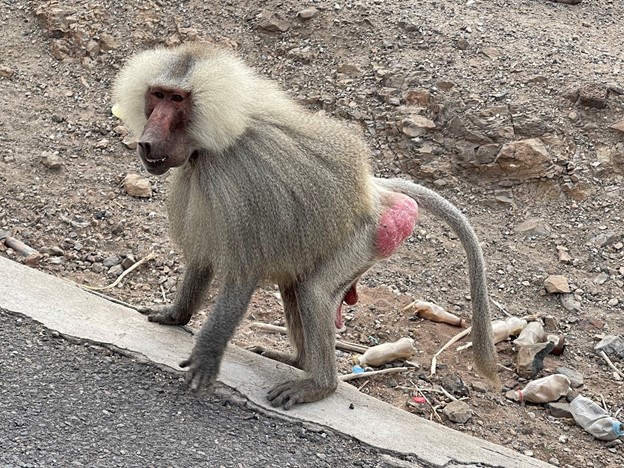
Baboon visiting the J28MD antenna field
Earth–Moon–Earth (EME)
Moonbounce is the technical pinnacle of ham radio and consists of sending amateur radio signals to the moon. A tiny fraction of those signals then get reflected back to Earth and are received by another ham located somewhere else on our planet.
This was the first-ever 2m EME operation from Djibouti and resulted in 131 QSOs. Emil, Dl8JJ, was in charge of the EME operation and he was challenged by the local RF noise, a frequent occurrence everywhere in our modern society. Thus, he needed to change the location of the 16-element portable EME antenna a few times during our stay here.
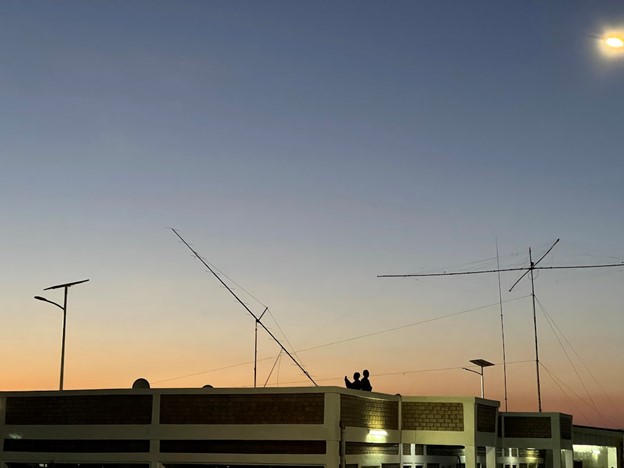
EME antenna, 80m vertical, and wire beam antennas in the sunset
Operating
After the antenna installation at the beginning of the DXpedition, where everyone participates, each operator had two daily operating shifts of three hours each and a day off so the operators could relax or make excursions nearby.
The focus of the DXpedition has been the “human modes” (CW and SSB), and that clearly shows in the log statistics. The CW contacts accounted for a whopping 35% of the total log with 25% in SSB while the rest are RTTY, FT8, and JT65 QSOs. J28MD was active in RTTY, giving those diehard RTTY operators a chance to add J2 to their logs.
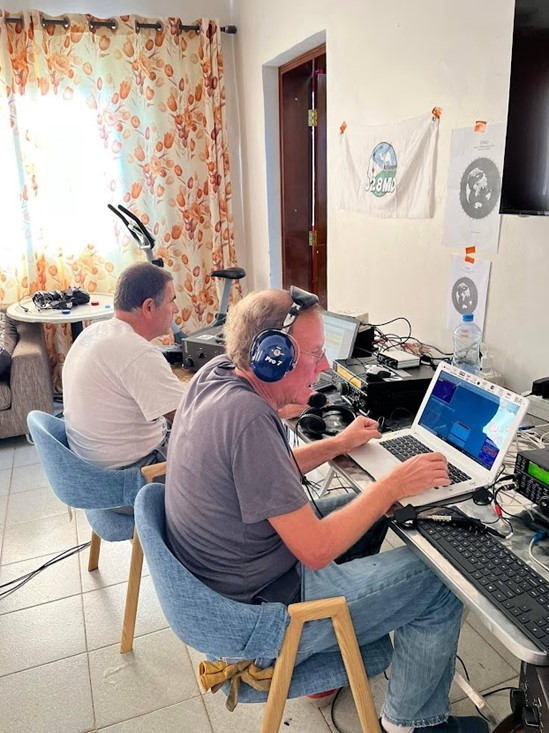
Fabio, IK4QJF, and Steve, AG4W, operating digital modes and SSB
Adrian, KO8SCA entertaining a local visitor For more details, statistics, and additional pictures from our DXpedition, please visit the DXpedition homepage and the J28MD Facebook page.
